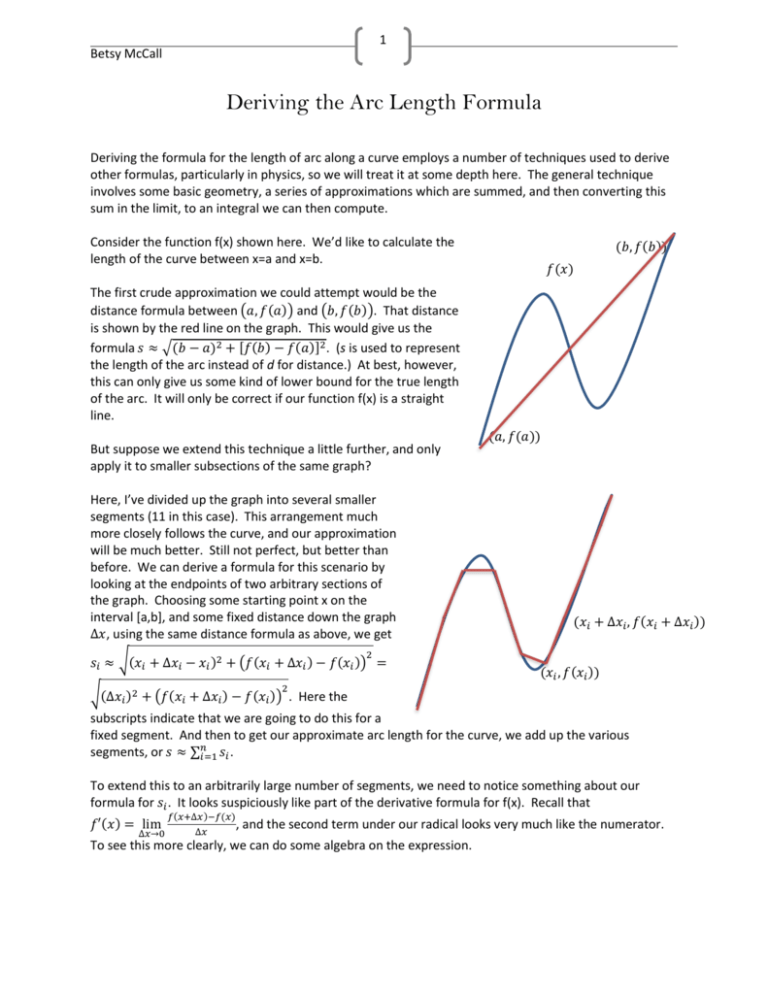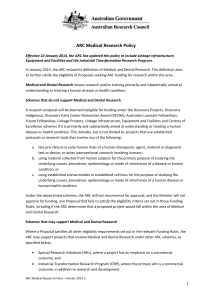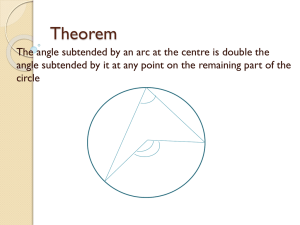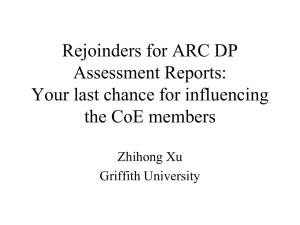Deriving the Arc Length Formula
advertisement

1 Betsy McCall Deriving the Arc Length Formula Deriving the formula for the length of arc along a curve employs a number of techniques used to derive other formulas, particularly in physics, so we will treat it at some depth here. The general technique involves some basic geometry, a series of approximations which are summed, and then converting this sum in the limit, to an integral we can then compute. Consider the function f(x) shown here. We’d like to calculate the length of the curve between x=a and x=b. (𝑏, 𝑓(𝑏)) 𝑓(𝑥) The first crude approximation we could attempt would be the distance formula between (𝑎, 𝑓(𝑎)) and (𝑏, 𝑓(𝑏)). That distance is shown by the red line on the graph. This would give us the formula 𝑠 ≈ √(𝑏 − 𝑎)2 + [𝑓(𝑏) − 𝑓(𝑎)]2 . (s is used to represent the length of the arc instead of d for distance.) At best, however, this can only give us some kind of lower bound for the true length of the arc. It will only be correct if our function f(x) is a straight line. But suppose we extend this technique a little further, and only apply it to smaller subsections of the same graph? Here, I’ve divided up the graph into several smaller segments (11 in this case). This arrangement much more closely follows the curve, and our approximation will be much better. Still not perfect, but better than before. We can derive a formula for this scenario by looking at the endpoints of two arbitrary sections of the graph. Choosing some starting point x on the interval [a,b], and some fixed distance down the graph ∆𝑥, using the same distance formula as above, we get (𝑎, 𝑓(𝑎)) (𝑥𝑖 + ∆𝑥𝑖 , 𝑓(𝑥𝑖 + ∆𝑥𝑖 )) 2 𝑠𝑖 ≈ √(𝑥𝑖 + ∆𝑥𝑖 − 𝑥𝑖 )2 + (𝑓(𝑥𝑖 + ∆𝑥𝑖 ) − 𝑓(𝑥𝑖 )) = (𝑥𝑖 , 𝑓(𝑥𝑖 )) 2 √(∆𝑥𝑖 )2 + (𝑓(𝑥𝑖 + ∆𝑥𝑖 ) − 𝑓(𝑥𝑖 )) . Here the subscripts indicate that we are going to do this for a fixed segment. And then to get our approximate arc length for the curve, we add up the various segments, or 𝑠 ≈ ∑𝑛𝑖=1 𝑠𝑖 . To extend this to an arbitrarily large number of segments, we need to notice something about our formula for 𝑠𝑖 . It looks suspiciously like part of the derivative formula for f(x). Recall that 𝑓′(𝑥) = lim ∆𝑥→0 𝑓(𝑥+∆𝑥)−𝑓(𝑥) , ∆𝑥 and the second term under our radical looks very much like the numerator. To see this more clearly, we can do some algebra on the expression. 2 Betsy McCall 2 𝑠𝑖 ≈ √[(∆𝑥𝑖 )2 (∆𝑥𝑖 )2 (∆𝑥𝑖 )2 (𝑓(𝑥𝑖 + ∆𝑥𝑖 ) − 𝑓(𝑥𝑖 )) √ + (𝑓(𝑥𝑖 + ∆𝑥𝑖 ) − 𝑓(𝑥𝑖 )) ] = ( + ) √(∆𝑥𝑖 )2 (∆𝑥𝑖 )2 (∆𝑥𝑖 )2 (∆𝑥𝑖 )2 2 2 𝑓(𝑥𝑖 + ∆𝑥𝑖 ) − 𝑓(𝑥𝑖 ) = √1 + ( ) ∆𝑥𝑖 ∆𝑥𝑖 Now, we see that the second term under the radical is clearly just the derivative 𝑓(𝑥𝑖 + ∆𝑥𝑖 ) − 𝑓(𝑥𝑖 ) ∆𝑥𝑖 →0 ∆𝑥𝑖 𝑓′(𝑥𝑖 ) = lim And so we replace that in the formula to get 𝑠𝑖 ≈ √1 + [𝑓′(𝑥𝑖 )]2 ∆𝑥𝑖 Then we take the sum of our n segments. 𝑛 𝑛 𝑠 ≈ ∑ 𝑠𝑖 = ∑ √1 + [𝑓′(𝑥𝑖 )]2 ∆𝑥𝑖 𝑖=1 𝑖=1 And finally, we let n become arbitrarily large and take the limit as n goes to infinity. 𝑛 𝑠 = lim ∑ √1 + [𝑓′(𝑥𝑖 )]2 ∆𝑥𝑖 𝑛→∞ 𝑖=1 This expression should look similar to something we’ve seen before as well. Recall the form of the Riemann sum for the definite integral was 𝑛 𝑏 ∫ 𝑔(𝑥)𝑑𝑥 = lim ∑ 𝑔(𝑥𝑖 )∆𝑥𝑖 𝑛→∞ 𝑎 𝑖=1 Where here, our 𝑔(𝑥) = √1 + [𝑓′(𝑥)]2 . Thus, the integral formula for the arc length is given by 𝑏 𝑠 = ∫ √1 + [𝑓′(𝑥)]2 𝑑𝑥 𝑎 In the future we will use the same technique to derive other versions of the arc length formula for parametric equations, polar equations, and multiple variable equations. We can also use this method for deriving a formula for the surface area of revolution. 3 Betsy McCall Now that we have the formula, we have other more practice problems to deal with. Working with this formula is not especially easy: easy enough to set up, but not always easy to perform the integration in practice. For the algebra to work, it is generally necessary to have very special functions that will cancel nicely with the square root in order to permit integration by hand. Or else, we must use more advanced techniques like trigonometric substitution. When these methods fail (and they generally will for arbitrary functions), we must resort to numerical methods to evaluate the integral. Practice Problems. 1. For each of the following functions, find the arc length by hand on the given interval. Give your answers in exact form, and then approximate them to 4 decimal places. 1 1 a. 𝑓(𝑥) = 6 𝑥 3 + 2𝑥 , [1,3] [Hint: you will need to FOIL, reduce and refactor under the radical.] 3 2⁄ 3 , [8,27] 1 1 b. 𝑔(𝑥) = 2 𝑥 c. ℎ(𝑥) = 8 𝑥 4 + 4𝑥2 , [1,4] 𝜋 3𝜋 d. 𝑘(𝑥) = ln(𝑠𝑖𝑛 𝑥) , [ , ] 4 4 e. 𝑎(𝑥) = cosh(𝑥) , [0,2] 𝑒 𝑥 +1 f. 𝑞(𝑥) = 𝑙𝑛 ( 𝑥 ) , [ln 2 , ln 3] 𝑒 −1 2. The formula for the arc length does not depend on which variable we call dependent or independent. Indeed, if x is a function of y, we can derive the formula for the arc length to be 𝑑 𝑠 = ∫𝑐 √1 + [𝑓′(𝑦)]2 𝑑𝑦. Use this formula to find the arc length of the curved below. 1 3⁄ 2 , [0,4] a. 𝑢(𝑦) = 3 (𝑦 2 + 2) 1 b. 𝑣(𝑦) = 3 √𝑦(𝑦 − 3), [1,4] 3. The following functions will produce arc length integrals that cannot be easily integrated using basic techniques. Use advanced integration techniques to integrate the functions, and verify the numerical approximation from your graphing calculator produces similar results. a. 𝑦(𝑥) = 4 − 𝑥 2 , [0,4] 1 b. 𝑟(𝑥) = 𝑥 , [1,5] c. 𝑠(𝑥) = sin 𝑥 , [0, 𝜋] d. 𝑤(𝑥) = 𝑒 −𝑥 , [0,2] e. 𝑝(𝑥) = arctan(𝑥) , [0,1] 4. Find the length of the arc along the following curves. Hint, the graphs are symmetrical, so find a segment of the graph (say ½ or ¼ of it) to eliminate any concern with negative signs, and then multiply that portion by 2 or 4 as appropriate to get the length of the complete graph. a. The arc length of the circle given by 𝑥 2 + 𝑦 2 = 9 2 2 b. The arc length of the astroid given by 𝑥 ⁄3 + 𝑦 ⁄3 = 4. 5. Compare the arc lengths on the interval [0,1] for each of the following functions. What do you notice about the lengths of the curves as the power changes? a. 𝑦 = 𝑥 b. 𝑦 = 𝑥 2 c. 𝑦 = 𝑥 3 d. 𝑦 = 𝑥 5 e. 𝑦 = √𝑥 2 f. 𝑦 = 𝑥 ⁄3 4 g. 𝑦 = √𝑥








